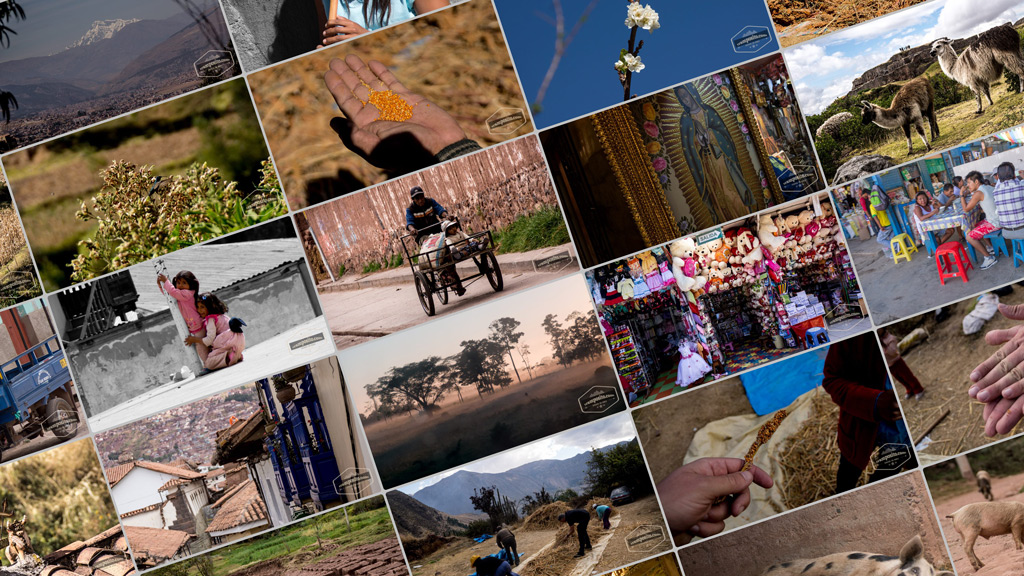forty four pictures of peru
forty four pictures of peru
In Summer 2013, during my journey to Peru, I made quite some pictures that do not fit in the scheme I usually publish. So I put them togehter here and commented each one.
|
001 - ausangate above cusco |
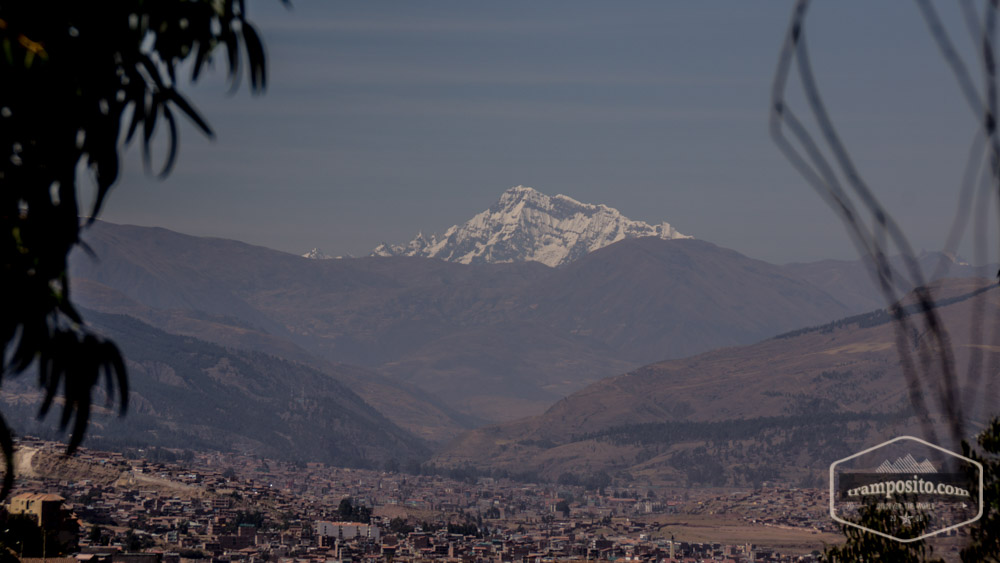 |
|
Ausangate (Quechua: Awsanqati) 6,384 metres On clear days the fourth highest mountain of peru can be seen from cusco in 100km distance. There is a more or less popular hiking trek around the mountain with passes above 5000m. The peak itself is a hard climb, seldomly undertaken. One main reason are the difficult conditions, caused by its proximity to the amazon rain forest and the weather that is cought on its eastern andean slopes close to this snowy peak. Beeing located at the spine of latin america, the andes, cusco with its elevation of 3,416 m seems to be close.
Mountains are of significance to the original beliefs of the people in times before the colonial conquest. Still they are today. Apu Ausangate, the Ausangate mountain god, is honored yearly with a big pilgrim to a glacier at the foot of the mountain and a spectacular celebration. |
|
002 - cusco - a hippy place |
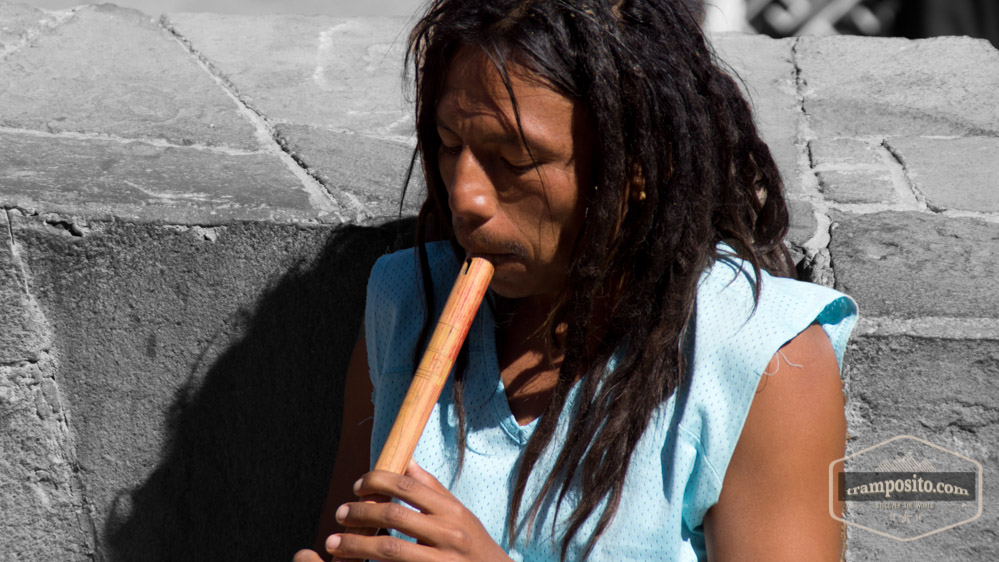 |
|
Remains of an alternative culture The roots of this cultural movement go back to the 1960s. While in countries where it started, the US and Europe, the signs got rare, in Cusco many people can be found that follow this way of life. There may be many reasons for them to be there. Sure there is a pleasant climate in the cities of high elevation and proximaty to the equator. It never gets too cold, never too warm. The other reasons surley are found in a powerful spiritual world with many places that hold a strong power. |
|
003 - Where there are rivers and no roads |
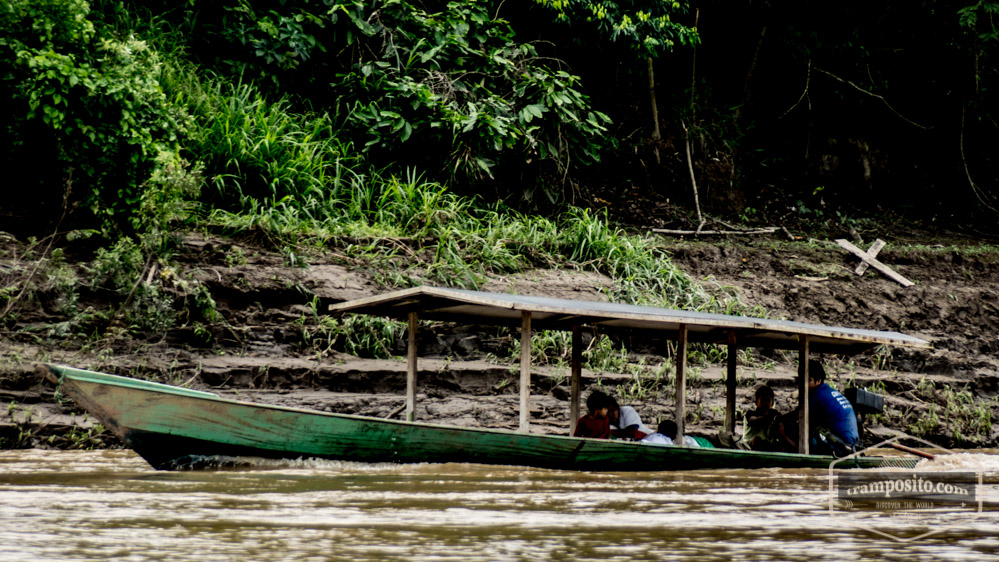 |
|
Madre de dios river A direct translation would say: the mother of god river. While Puerto Maldonado, the regions capital, can nowadays be easily reached by the interociana, the Interoceanic Road between the Pacific (Peru) and Atlantic Oceans (Brazil), the transport medium in the amazon rain forest is the motor canoe. Big streams are the main roads. |
|
004 - The streets of coya |
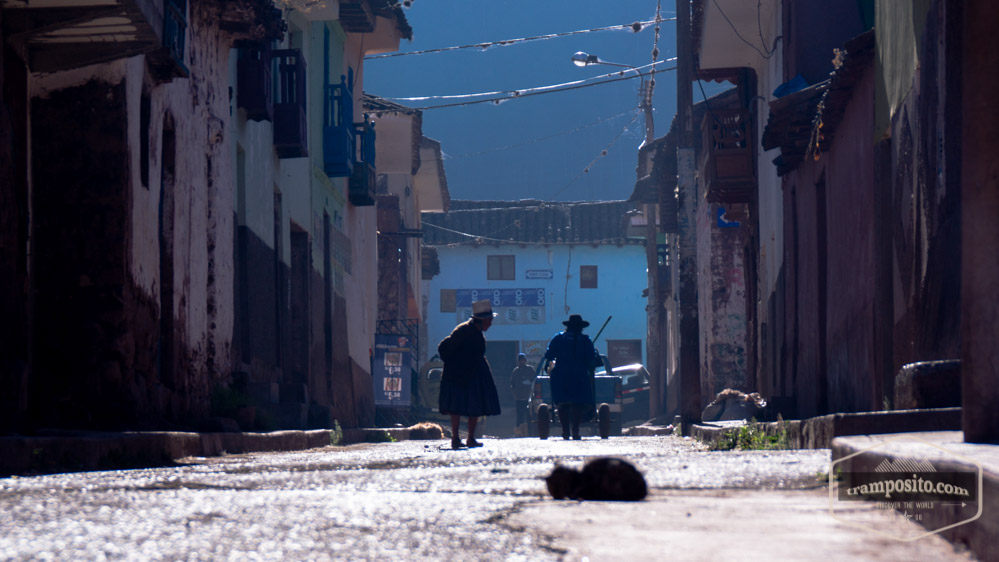 |
|
Live goes a different pace Thanks to a dear friend I had the chance to explore the country besides to that what is easily and normally open to the tourists. This morning I got up early to walk with her fathers to the fields in the hills above the village that is located in the ground of the sacred valley. We seek the workers helping him with the farming work, organize the day. It is early morning and the place awakes slowly. These workers have many duties to take care of. They need to look after their housholds and families. Organizing things with the autorities takes them a lot time with bus rides and waiting times in offices. |
|
005 - Where corn comes from - 1 |
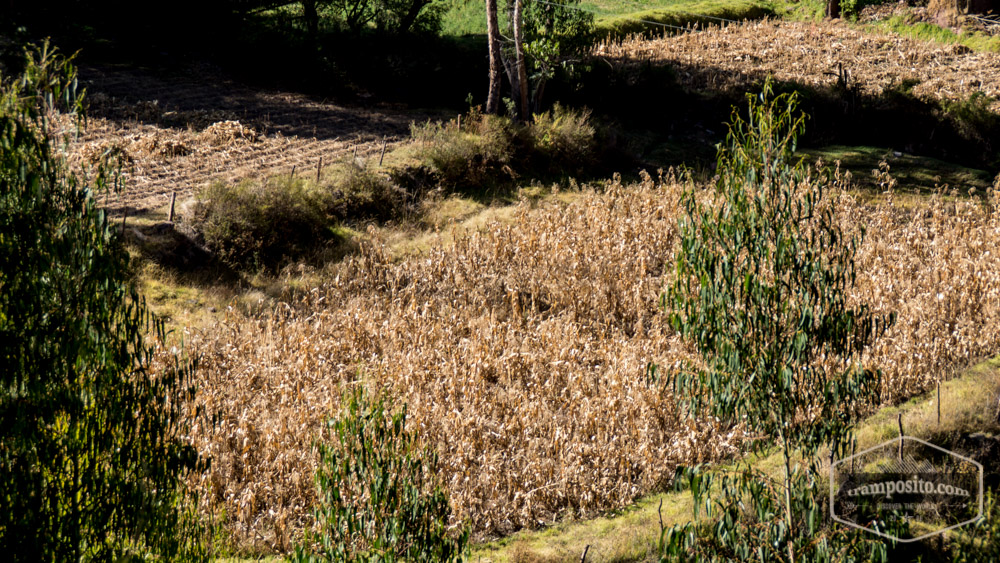 |
|
A harvest the traditional way Corn has its origins in Mexico. From there it founds its way to other parts of latin america. Traditionally the grain of corn is harvested here. The plant is seeded in the fields. The plant grows and and finally turns from a green to a dry state. The corncobs are picked by hand from the workers. The small, terraced fields in the hills of the sacred valley are not suited for big agricultural machines |
|
006 - Where corn comes from - 2 |
 |
|
The power of the sun - drying corncobs At the time of picking the corncubs still hold quite some moisture. In order to make corn durable it needs to be dried. The strong sun close to the equator is a good helper to do so. However during these days the corn is volnerable against seldomly occuring rain in the dry season. |
|
007 - Where corn comes from - 3 |
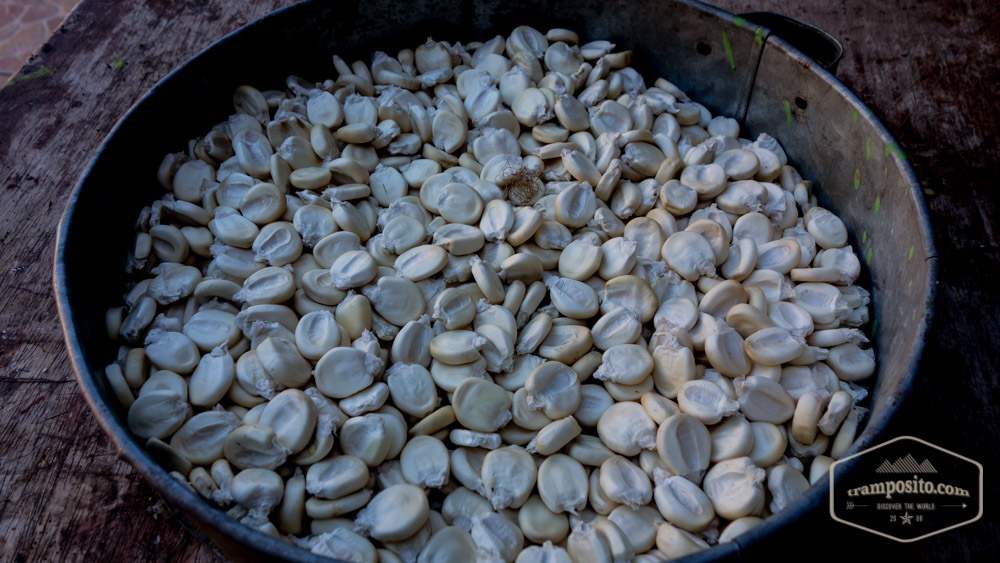 |
|
Getting the grain of corn Once the corncobs are dried, they are packed into big bags and brought to the families home. For several days worker will sit together in the patio to separate the grain of corn from the corncobs. Grain of corn of poor quality is sorted out. |
|
008 - Where corn comes from - 4 |
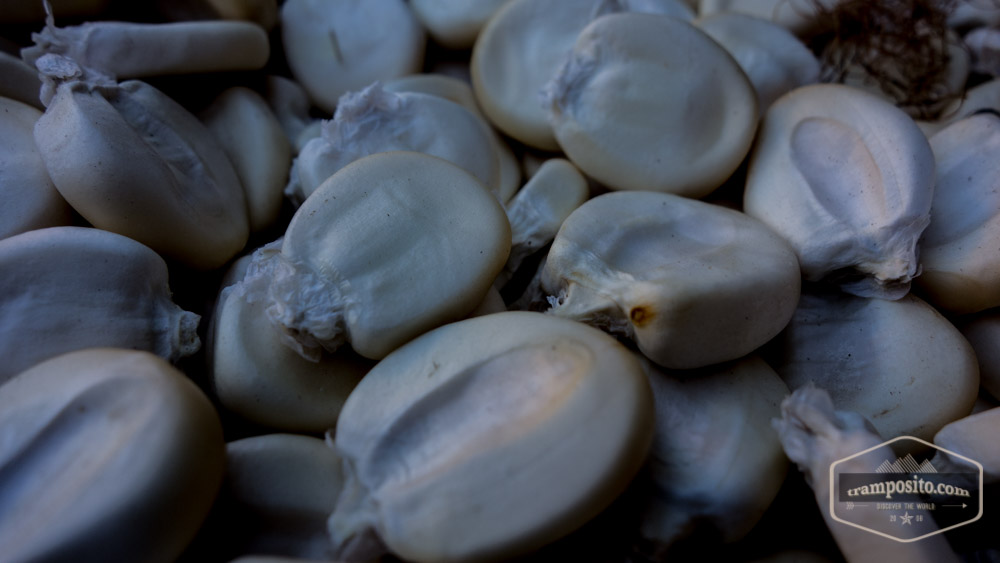 |
|
Maize blanco - white corn The particular climate in this part of Peru allows to produce the special white corn. In good quality it can be sold to the US and Japan. However still it is difficult to make an approciate price for the necessary amount of hard manual work. |
|
009 - Natural Paradise |
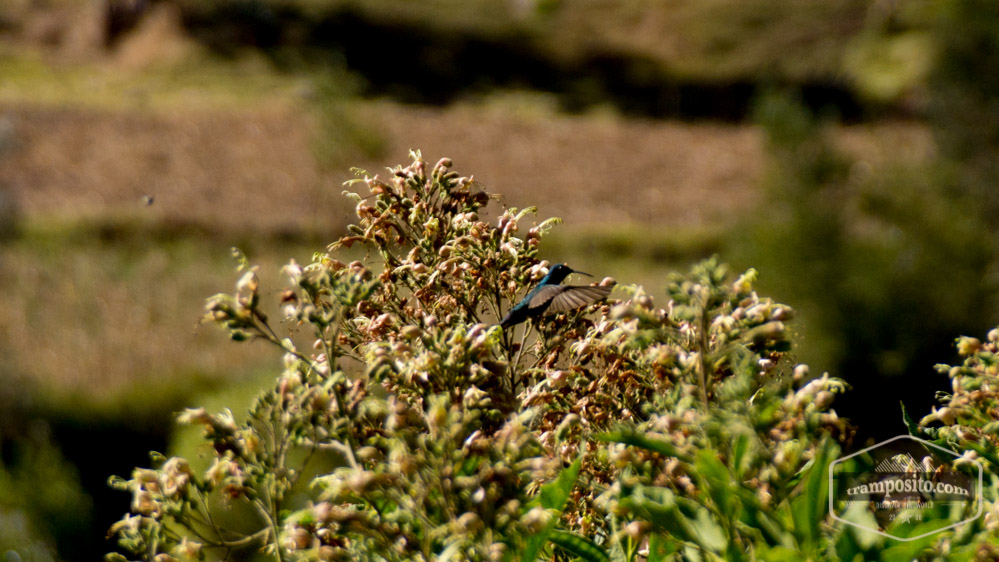 |
|
Wildlife and cultivated land - hand in hand This traditional way of farming with small fields and little use of technology leaves space for natural diversity. Humming birds fly around us as we take care of the harvest. |
|
010 - Quinoa - Part 1 |
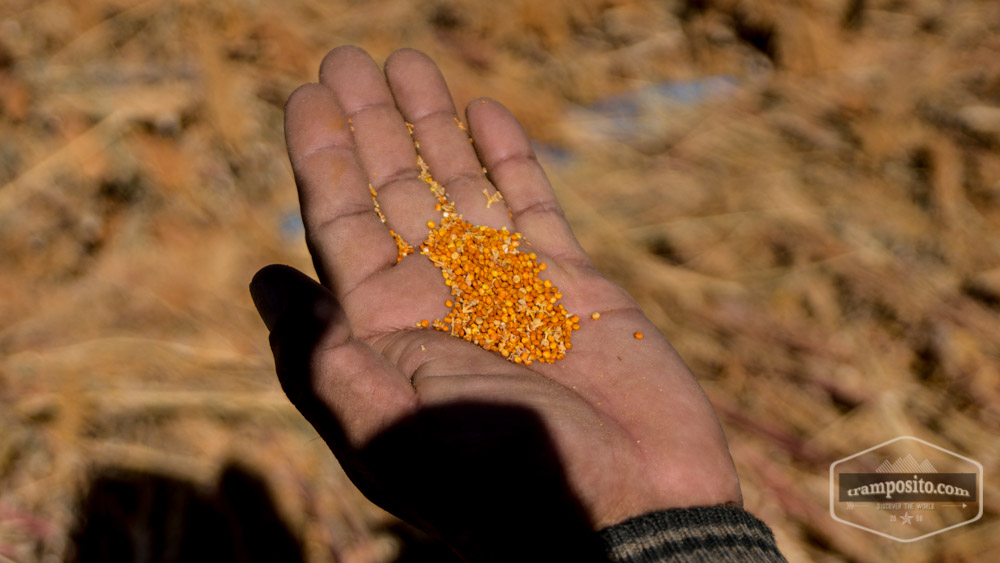 |
|
The rice of the inca The UN declared 2013 to the "year of the quinoa". The plant is paticular and even grows in elevations above 4000m in the andes. Once, together with amaranth, it had a major role in the diet of the habitants of the mountains of latin america. With the global trade of food in our times it lost its role. Today it is eaten less often by the locals, however on the other hand sold to the world as a speciality. |
|
011 - Quinoa - Part 2 |
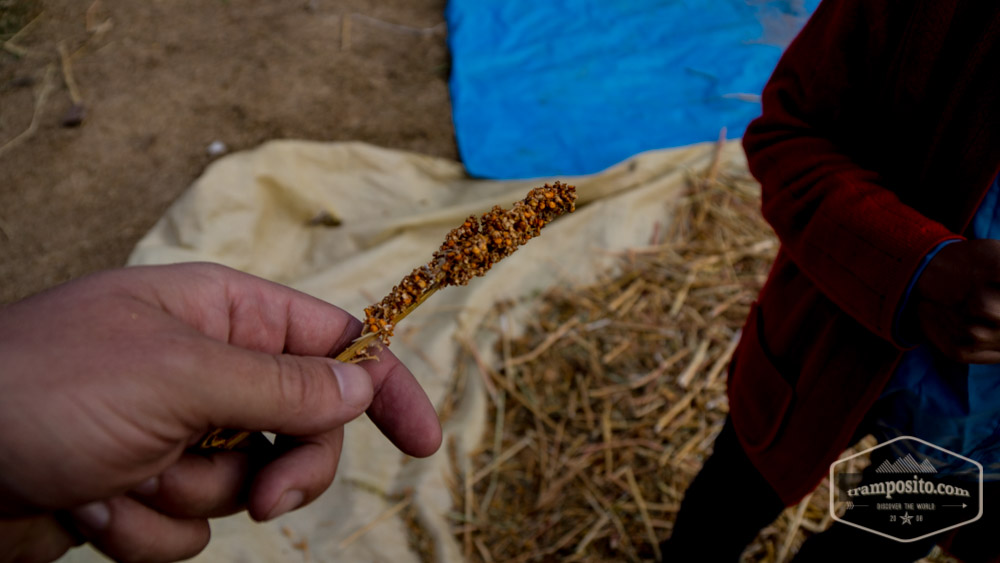 |
|
The plant The seeds grow attached to the stem. |
|
012 - Quinoa - Part 3 |
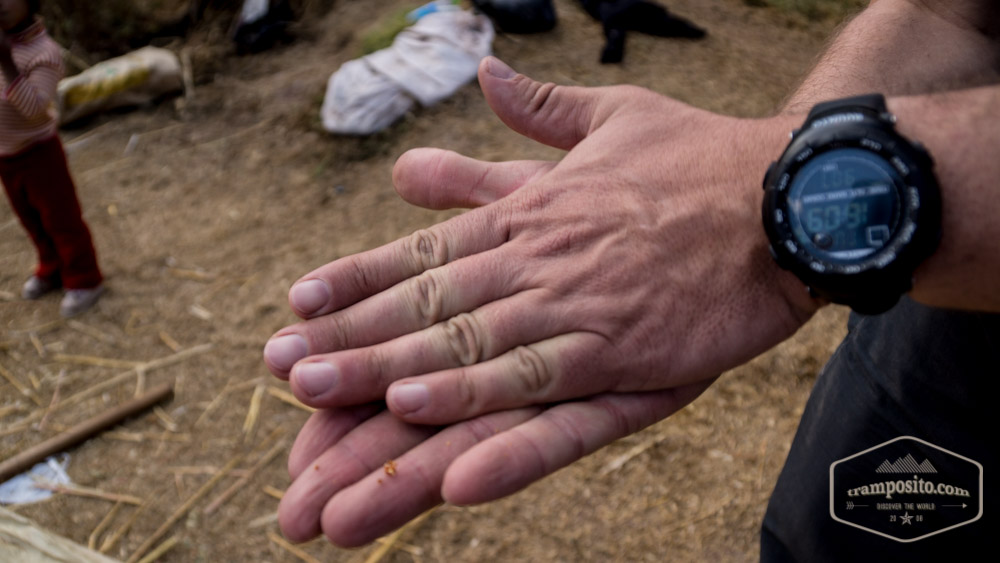 |
|
Getting the seeds In order to check the quality of the seeds the stem is taken between the hands. After some circular movments of the hands against each other the seeds are separated from the stem. |
|
013 - Quinoa - Part 4 |
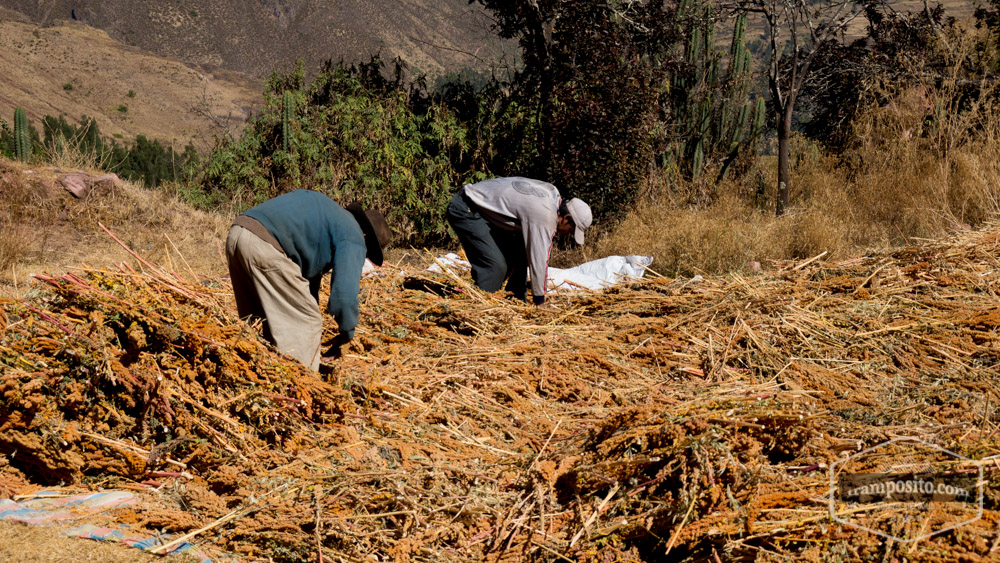 |
|
Drying follows cutting Once the plants are mellow they are cut as wholes.They are collected and brought to a central drying place. Coutiously they are distributed above a plastic plastic blanket. After some days the plants are flipped to support drying. |
|
014 - Quinoa - Part 5 |
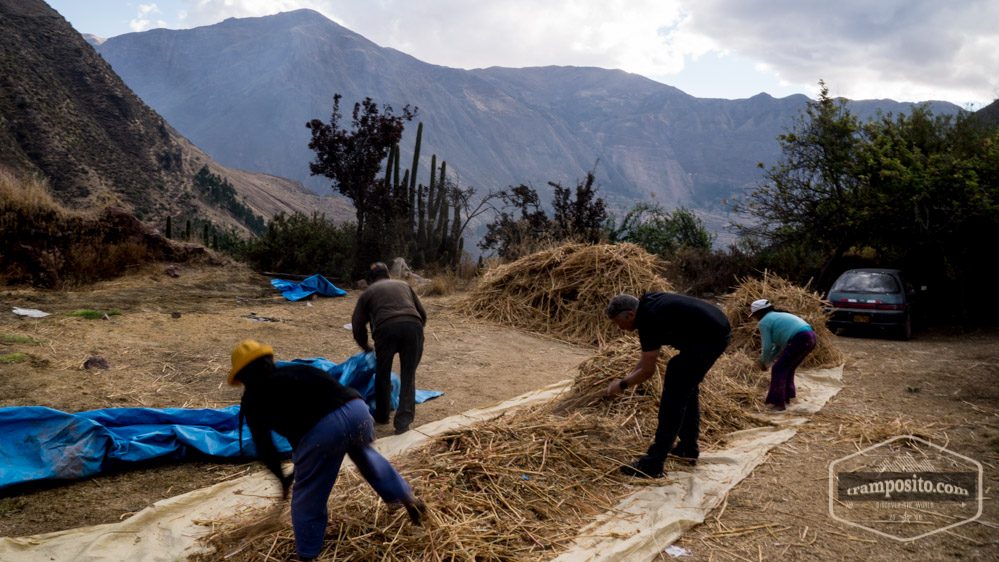 |
|
Bashing the seeds from the stems When the quinoa is dry enough the seeds are separated from the course stems by bashing with sticks on stacks of plants. The seeds are concentrated on the plastic blanket. |
|
015 - Quinoa - Part 6 |
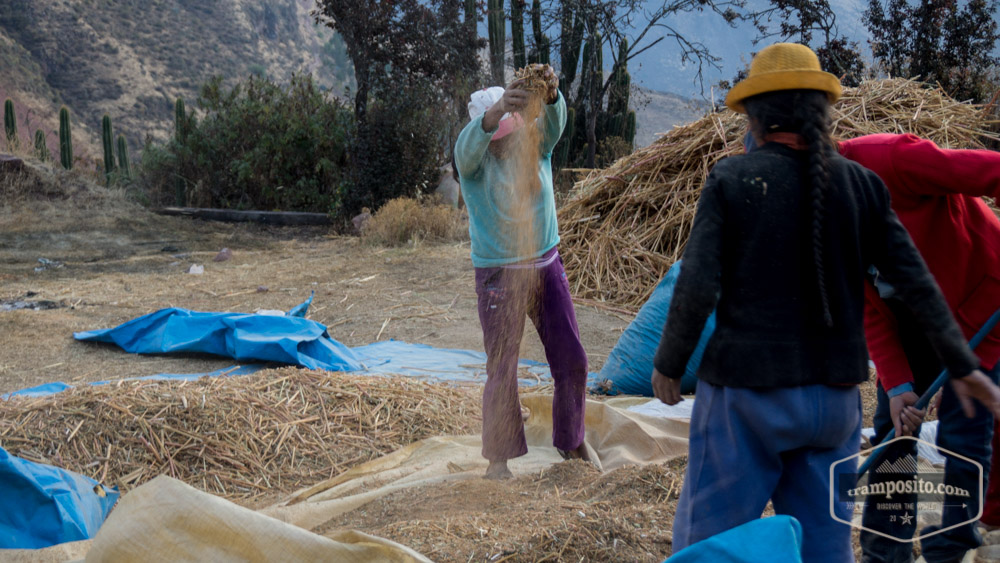 |
|
The helper wind - if it is there Wind takes away the light and useless parts of the harvest. Of course it is not always available, too weak today. The crop of today is packed in bags. It needs to be cleared and filtered back home the next days. |
|
016 - Quinoa - Part 7 |
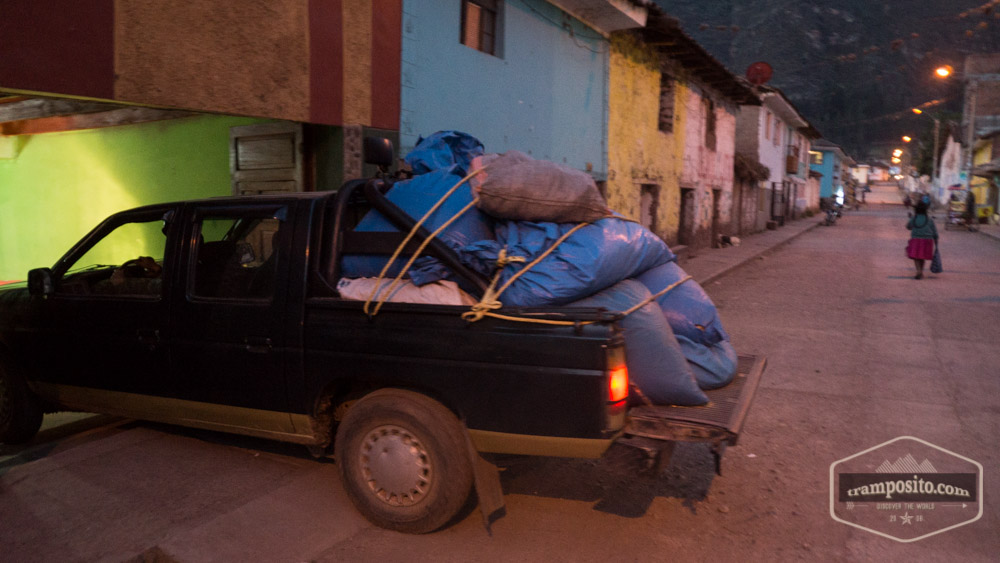 |
|
Todays harvest brought home Having put all the crop of today into bags we load it onto the families pick up truck, secure the bags with a rope. By the way: I once drove the car on the rough roads outside the village. A very exciting experience! |
|
017 - Peaches blooming |
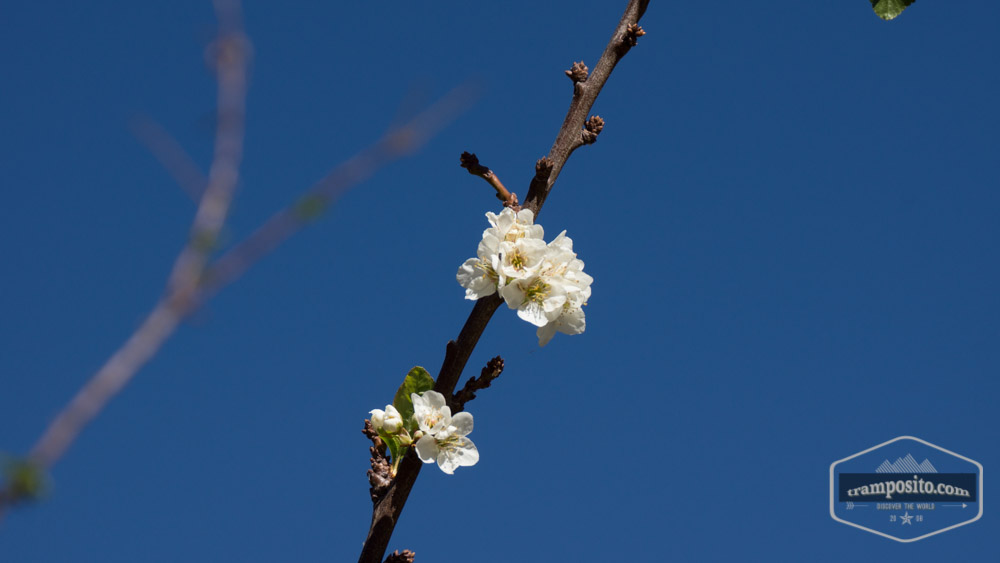 |
|
Flowering to develop the fruit The pleasant climate of the sacred valley allows not only to grow the traditional plants. Carlos planted peaches on his fields. They are less work and an economic alternative. |
|
018 - love and emotion |
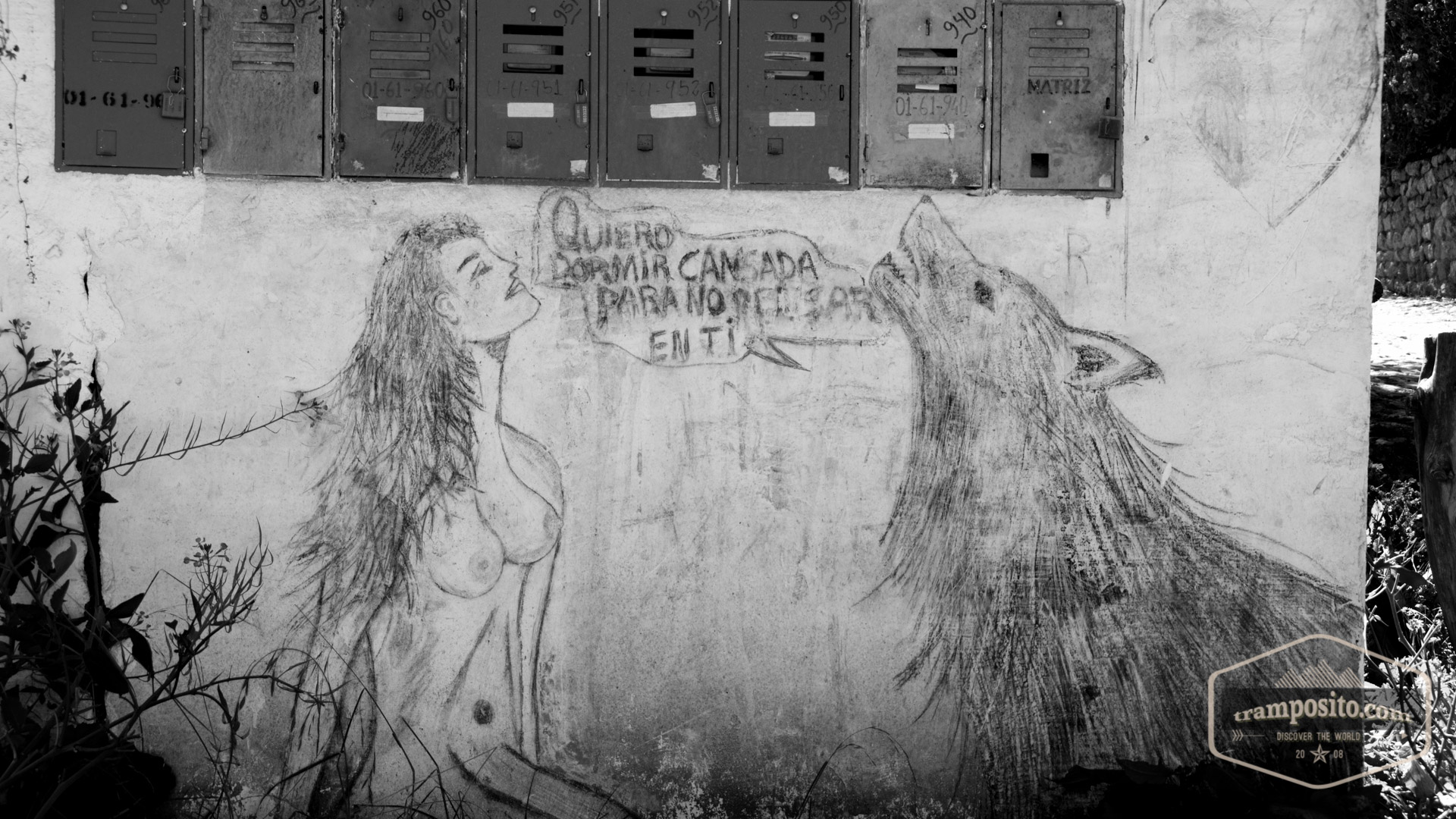 |
|
I want to sleep deeply - not to be thinking of you. While strolling through Cusco I found this painting at a house. To me it is a beautiful example for the latin people's passion and their capability to express themselves in powerful art. |
|
019 - Wanna ride |
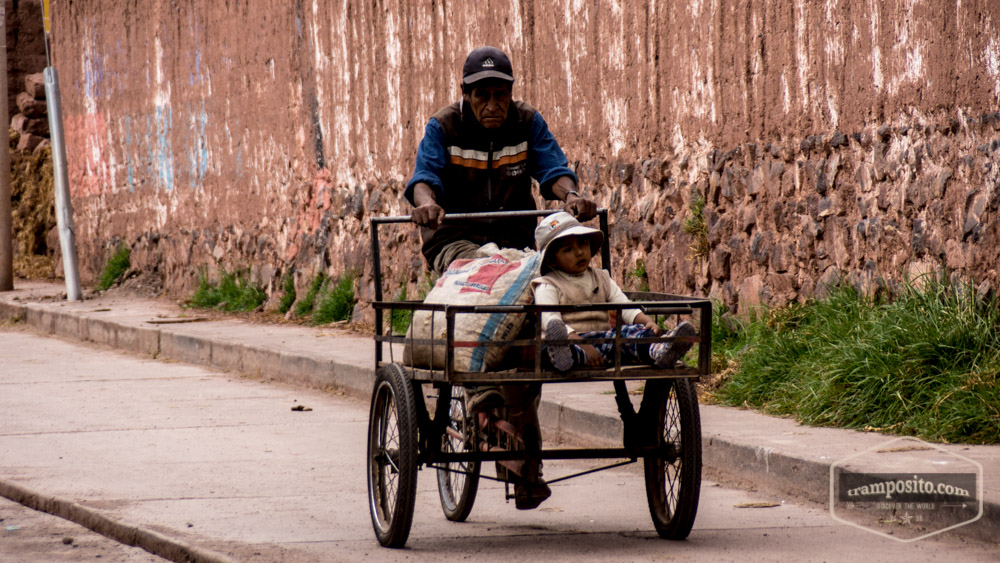 |
|
Getting around in the streets of coya The little girl got a lift on her grandpas rikshaw. |
|
020 - The smiling children |
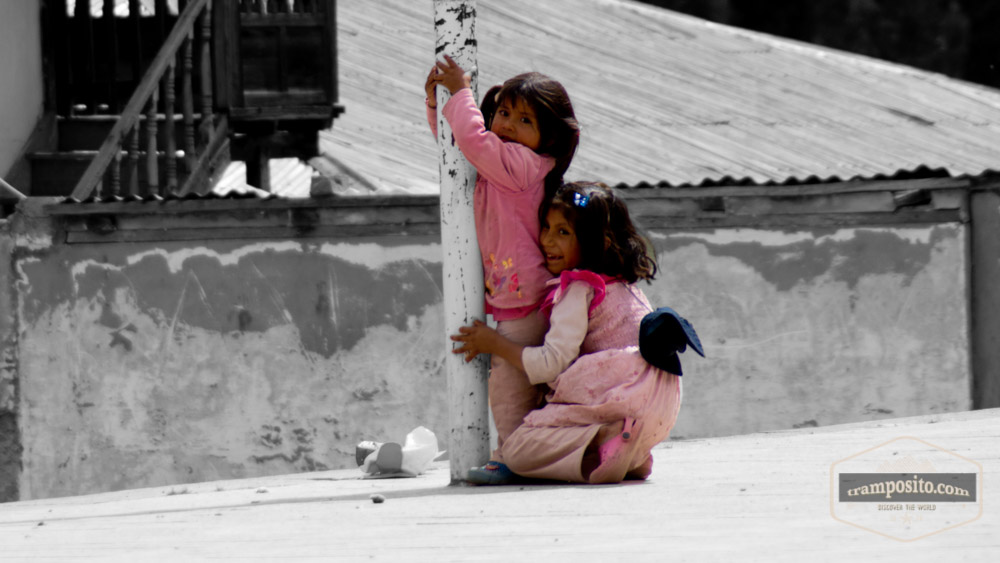 |
|
The girls playing with each other During daytime the central place of coya is tranquil. Dogs stroll around and the kids are having their fun. |
|
021 - Religion |
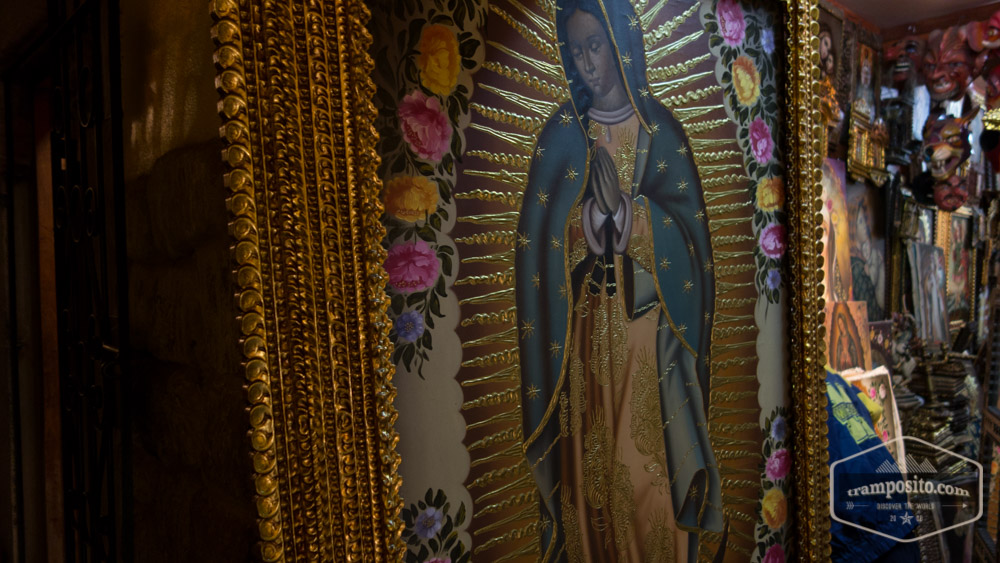 |
|
Icons in a religous clash With the Europeans that spread themselves over latin americas land, the christian doctrine was rolled out. Today it is the most present religion in Perus culture. Impressive churches, often richly decorated with gold and and paintings, are the most obvious sign. Shops offer a big variety of paintings and icons. Besides that, if one has a closer look, the traditional believes survided until today - despite of beeing fought hard. Pachamama, mother earth, ist the best known symbol in this believes. Today to some extend the belives even stand side by side.
|
|
022 - Perus Animals - Llamas |
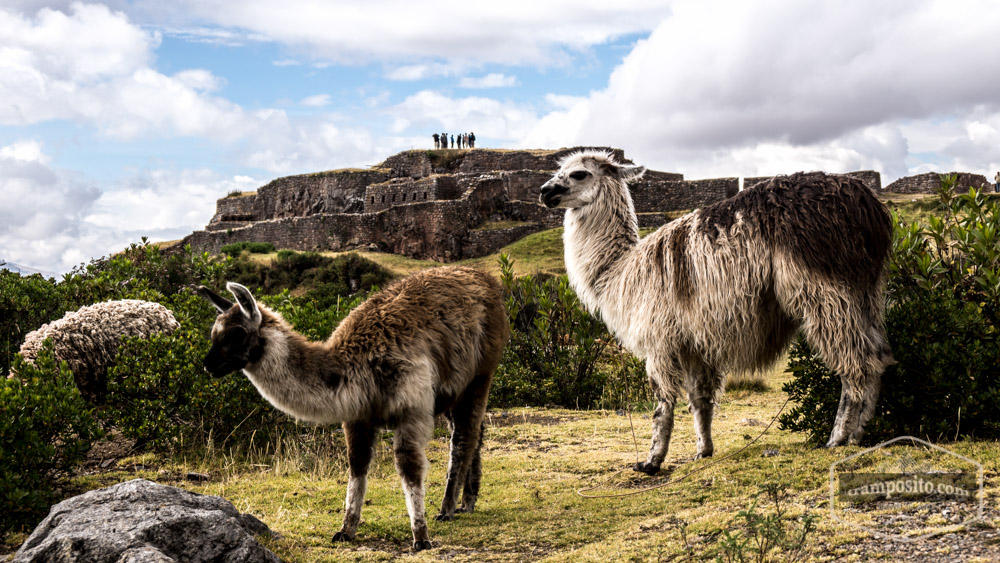 |
|
The andean camelid 5000 years ago the animals were domesticated in the wide plains of the puna at an altitude of 3200m. Still today it is important in Perus agriculture in the high altitudes. They help as pack animals and their wool is popular for clothes. Also the meat is eaten, however it is not so popular. The family of the Llamas is completed by the smaller and fine haired alpacas, the wild living and bigger guanaco and the smallest and most fine haired of the group , the vicuna - also living wild. |
|
023 - Architeqture of the incas |
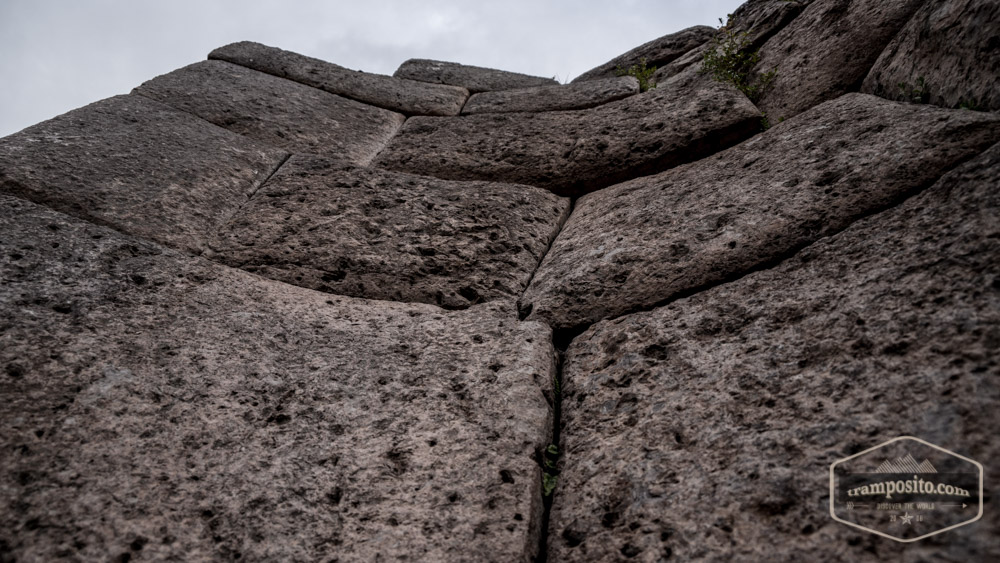 |
|
Puca Pucara, an inka fortress just above cusco The traditional archtecture of the inca times can still be found in many places of the highlands of Peru. Stones wore worked very precisly to fit the neighboring one. They are fitted without any mortar. Those fine peaces of crafts managed to survive until today, withstood the signs of time and the many earthquakes that frequently shake these young mountains. |
|
024 - Architeqture - rooftop blessings |
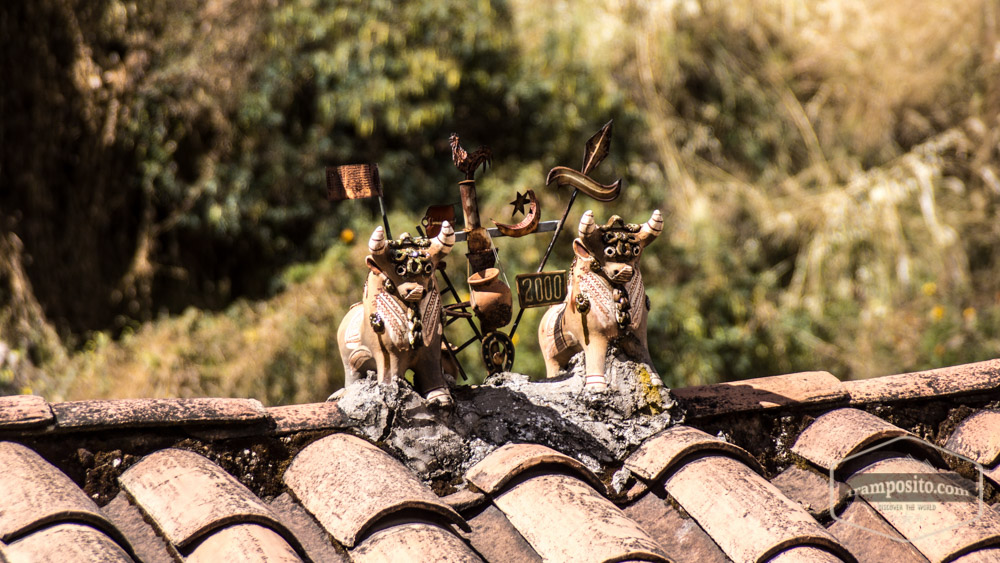 |
|
Torito de Pucara Torito de Pucara is the name of this ceramic sculptures. A pair of bulls combined with other important symbols are placed on the rooftop of the housings. With the first blessing of the new home they are placed to honor pachamama. They represent happiness, wealth and fertility. |
|
025 - Architeqture - colonial buildings |
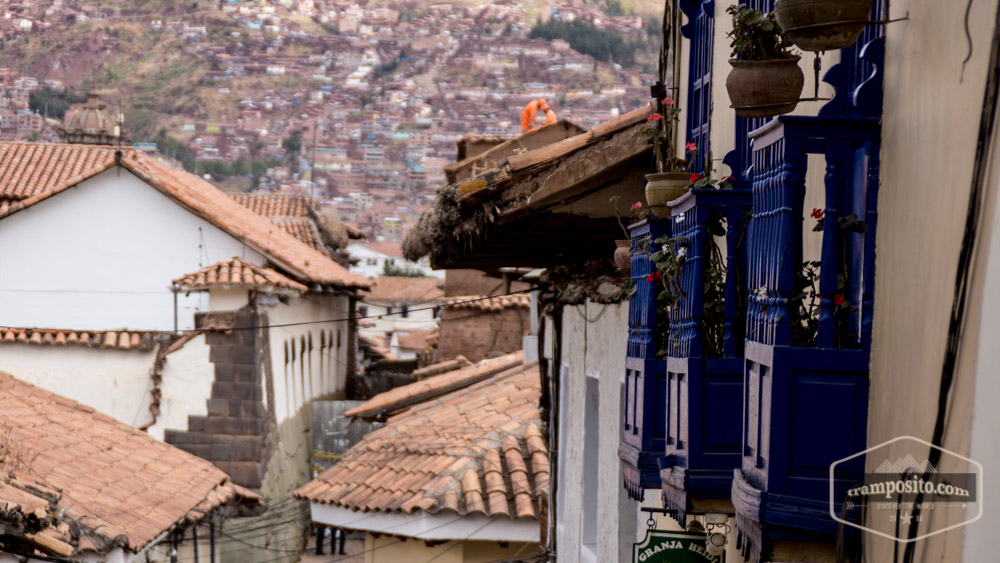 |
|
Mediteranian flair in southern america Many of the new settlers on the in Peru had their roots in southern Europe. The main inspiration from back home, combined with inspirations of the new world led the the colonial style in architecture. Many of the houses are well built and withstood centuries. Charming patios and colourful paintings make these houses particular. |
|
026 - Weaving |
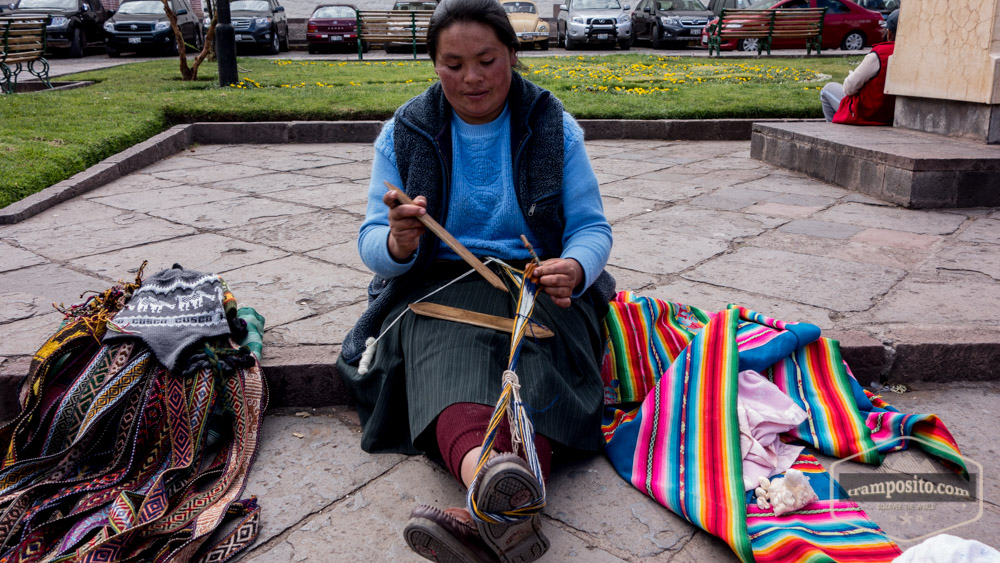 |
|
Weaving - the traditional fabrics production Wool that is cut from Llamas is yarned and coloured. The yaw string then is used to weave fabrics with traditional patterns and of plentyful colours. This women took a seat in the streets of cusco and demonstrates the craft. At the same time she sells some of her products to tourists passing bye. |
|
027 - The high mountains |
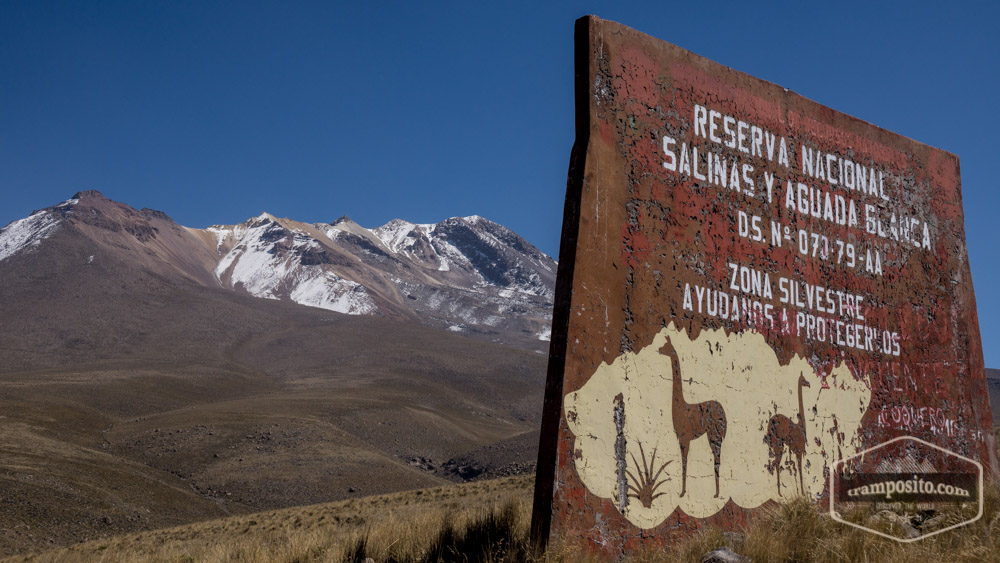 |
|
The tropical mountains Compared to european scale the mountains are of a different league here. With summit altitudes over 6000m the thin air bears a new challenge to reach summits. The technical difficulties in the high mountains vary greatly. But also the approach is different. The picture here is taken at 4500m - just one meter beneath the car. The 4wd vehicle brought us even up to 5000m. Bisdes these easily reached peak just outside Arequipa, Nevado Chachani, quite some mountains in this area wait for their first ascent. It is not primarily the technical difficulty, it is more the remoteness and the lack of water supplies that make them challenging. |
|
028 - Amazonian Rainforest |
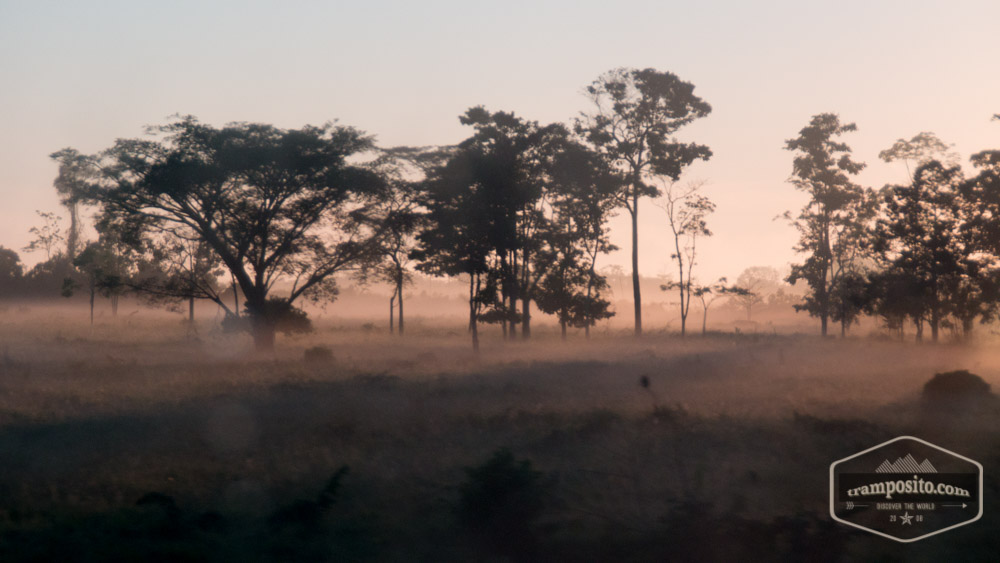 |
|
Rain forest - the less known side of Peru The amazon river has its origin in Peru - at Nevado Mismi close to Arequipa. From the height of 5170m it flows down the slopes of the Andes to become the big and well known stream in the amazonas basin. Actually 60% of Perus territory belongs to the Selva, the rainforest, zone. This side of Peru is not so well known, however worth in any case to be explored. On the one hand improved infra structure, in particular the interociana, made access much easier today. On the other hand of course also in Perus amazon basin nature is constantly threatend to loose ground to ever strenghtening civilication. |
|
029 - Shopping |
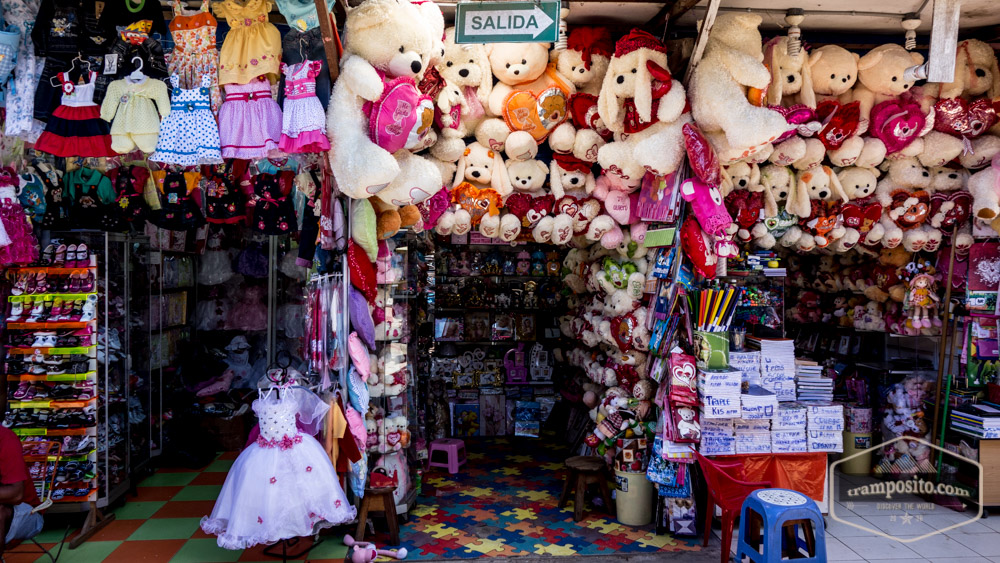 |
|
Shopping the peruvian way Any bigger place in Peru has its shopping areas. Often they are arranged in markets. Small shops are located side by side. Similar shopping content are located next to each other. So they battle hard to attract the customers. In the end there is a place for all of them. |
|
030 - Cookshops |
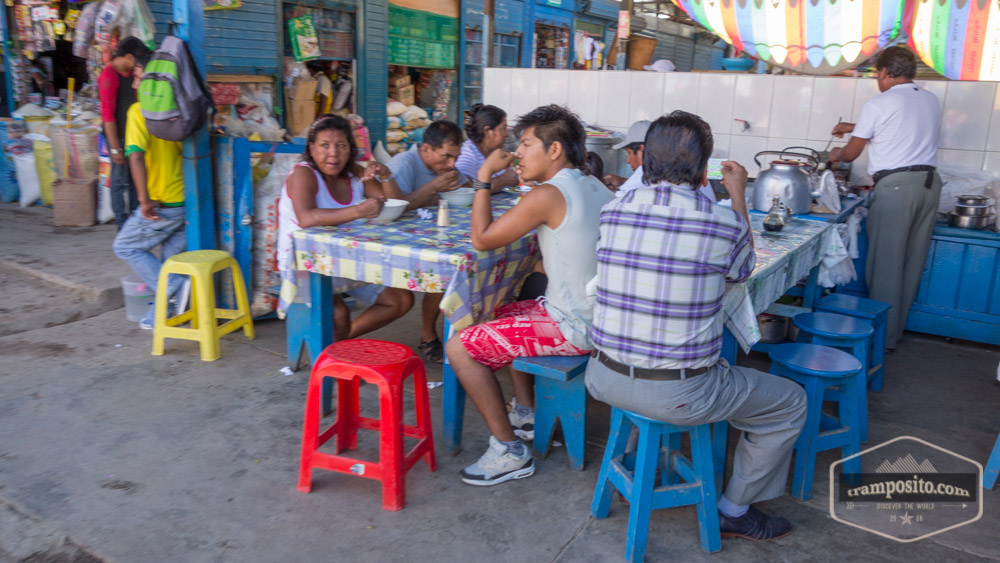 |
|
Eating the peruvian way Of course one can taste the wonderful flavours of peruvian kitchen in restaurants. However the real taste is experienced in the cookshops where locals fills their stomach. Go their for the real experience. A robust stomach and not too volnerable senses hoever help to have a good time. |
|
031 - It is a hard life |
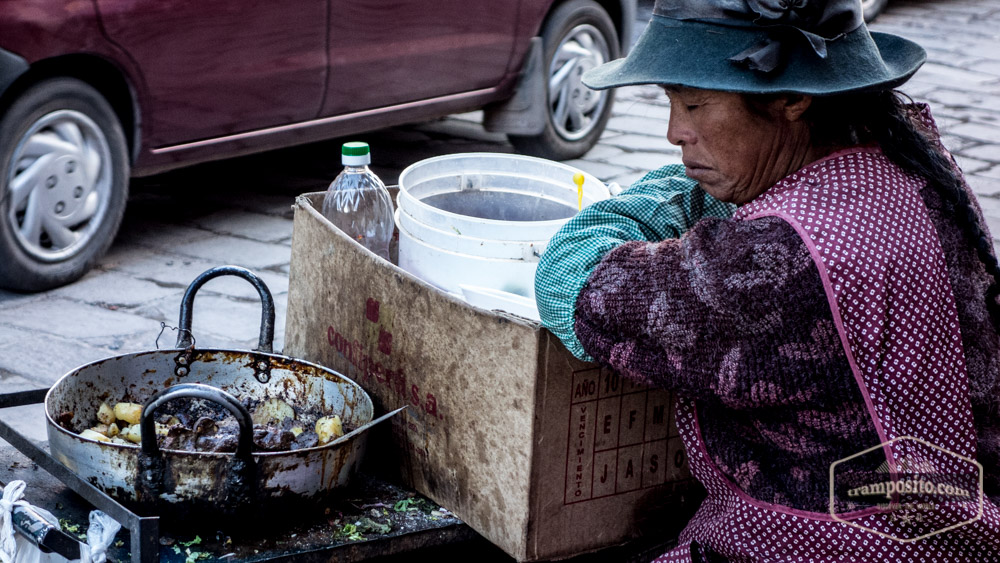 |
|
Live is difficult - for many Over the centuries the culture of this countries got shaken often in hard ways. The original people once were reorganized by incas, conquering more and more territory throughout what is today Equador, Bolivia, Peru and Chile. Compared to that what followed this is considered to have happened a rather peaceful way. The spanish conquest and the following colonial times where a hard clash to the people that used to live on this land. The new weapons and even worse, the imported deseases hit the people hard. An unknown dimension of violence and helplessness against infectios diseases hit the continent. The bodies of the local people had no defence to fight introduced viruses and bacteria. The countries and its people where exploited to the maximum. The following independancy wars established sovereign states. Old roles and still diffcult stability didn't close the gaps between the parts of the society. Situation today slowley improves, however still the social content you are born in will decide about you stand in life. It decides about your chances on wealth and education. If your only equipped with little of both you will find youselves at the edge of society, struggling to survive with long working days and the little income by your infomal buisness or hard work. When you leave the main tourist treks you will find many men and women like this is the streets of cusco. They prepare simple, however often tasty simple meals for the locals doing their buisness in the city. Their little income makes them surviving in a society with a weak social security. |
|
032 - Adobe building |
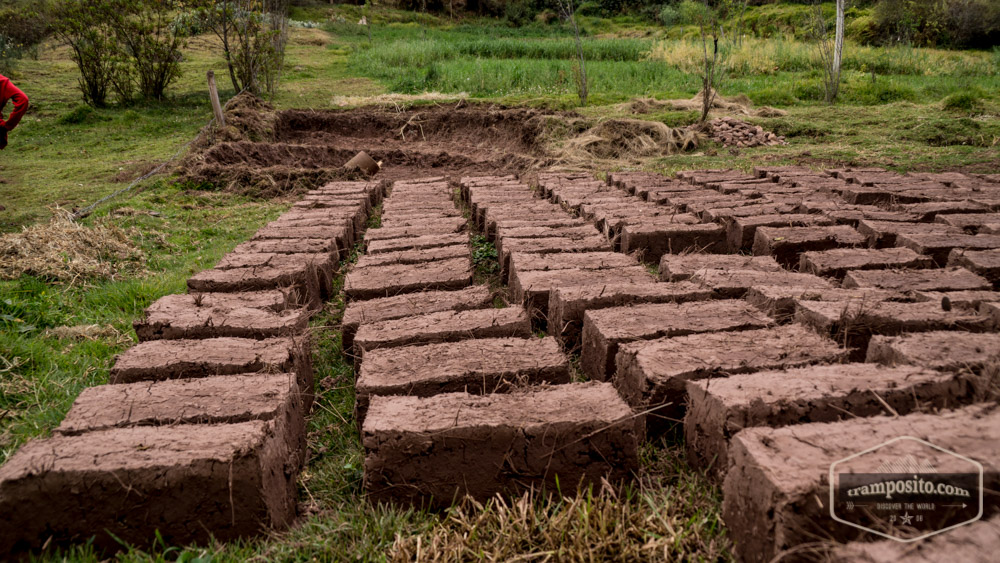 |
|
Adobe - the natural building material |
|
033 - It is all there |
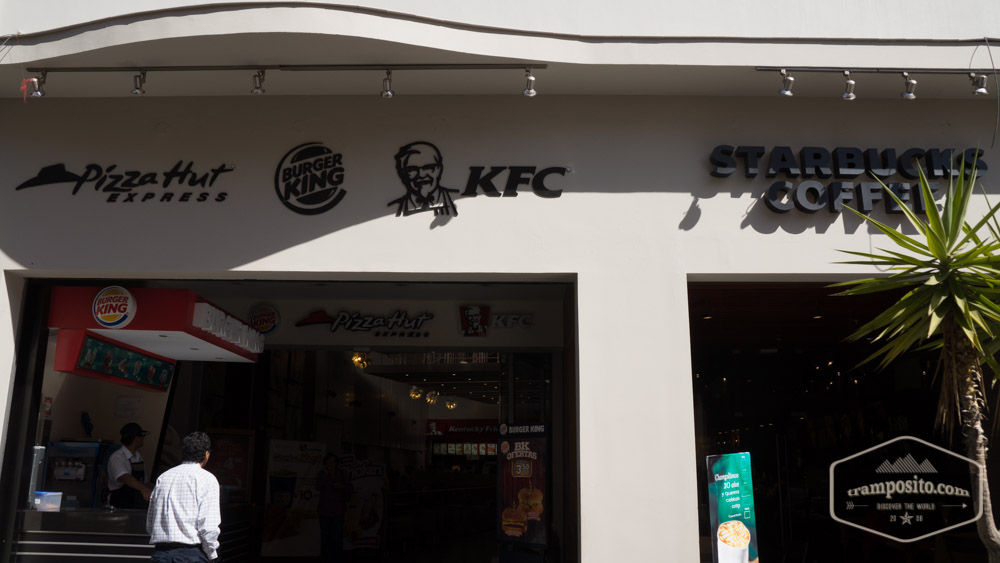 |
|
A uniform world? |
|
034 - The esthetics of beeing old |
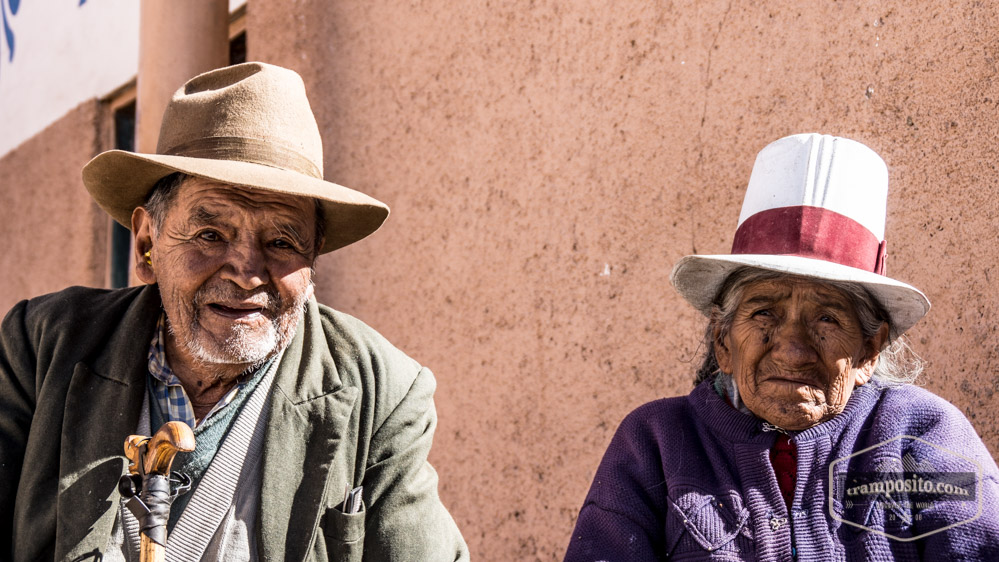 |
|
The dignety of the old While we stroll around the streets of a little tranquil place named maras I see these two elderly people sitting at the roadside.They have done the amount of work that was foreseen in their lives. Now the watch the live in street and chat with the people passing bye. I needed the help of my friend to ask them for permission for the photo. They only speak quecha, wouldn't understand my spanish. |
|
035 - Churches everywhere |
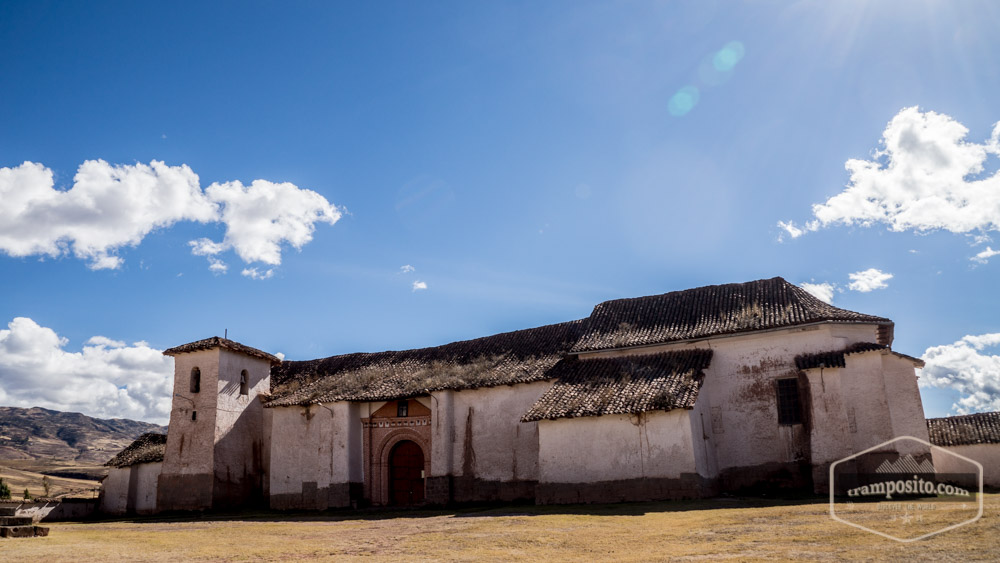 |
|
The dignety of the old - part 2 Besides the impressive cathedrals of the big cities churches can be found all over Peru. This one is located in Maras, serval kilometers outside Cuzco. |
|
036 - Mother and children |
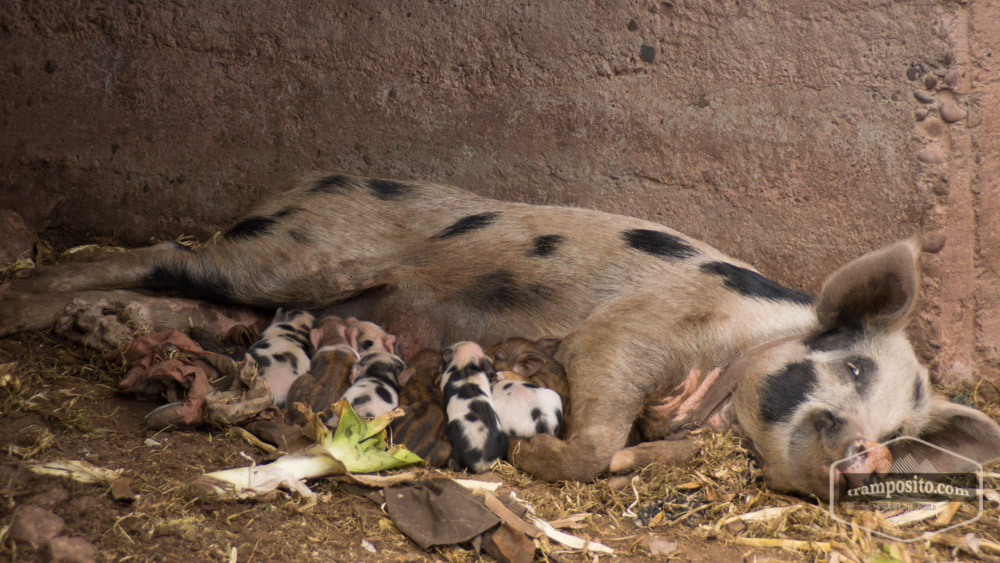 |
|
Cute - aren't they? I took this picture in the hills above Coya. I don't know much to say about, just that I like it. |
|
037 - Inka construction work |
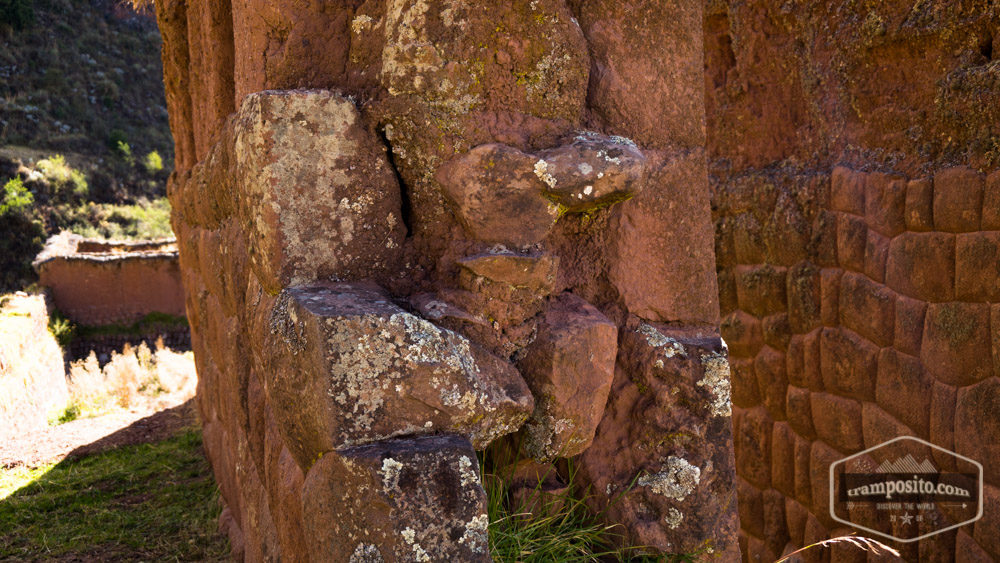 |
|
The triple layer walls The walls are aligned very precisly at the outside, stones are worked that way, that they fit together acurately. This applies to the outer surfaces of the construction. The core of the wall is filled with loose stones and adobe. The picture is taken at the archaeological site of HUCHUY QOSQO, meaning as much as little Cusco. |
|
038 - Inka construction work - part 2 |
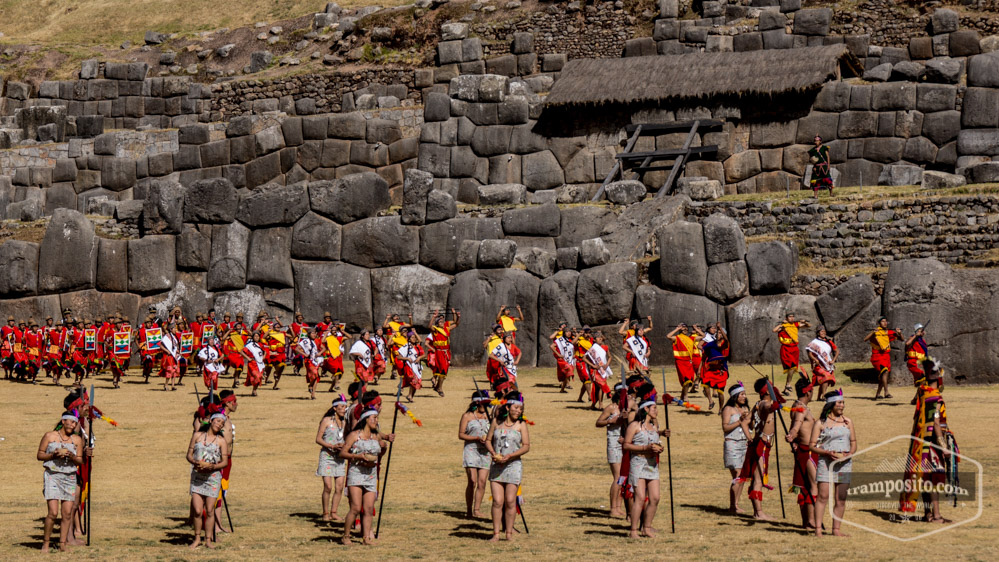 |
|
The big blocks Sacsayhuaman, a former fortress right outside Cusco city is one of the most impressive sites to inspect the construction art of the Inkas. Huge blocks are worked precisly to fit another. The area hosts the yearly Inti Raymi festival. |
|
039 - Butterflies of the rain forest |
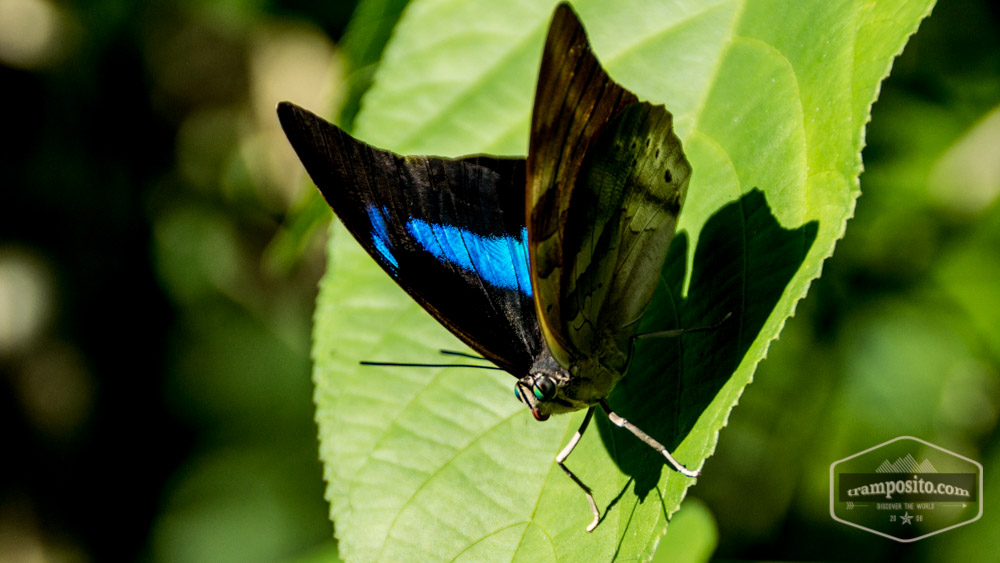 |
|
Different dimensions The biodiversity in the rainforest is a wonder of sound, size, beauty and plentiness. Butterflies like this one have the size of a human hand. |
|
040 - Getting around |
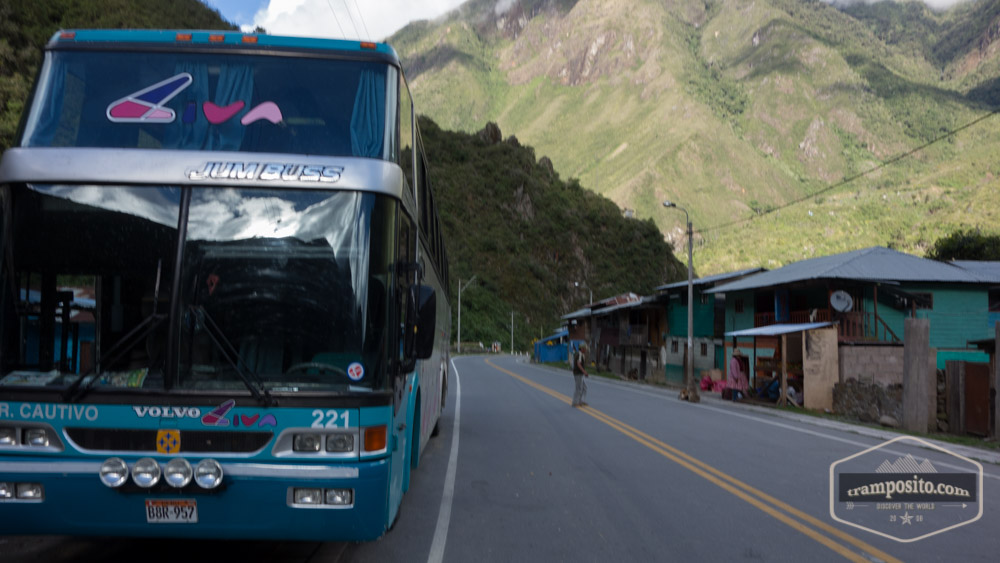 |
|
Travelling by bus. Peru holds a very good network on bus connections. So this is the standard medium for travelling - used by locals and by tourists. |
|
041 - Windy roads |
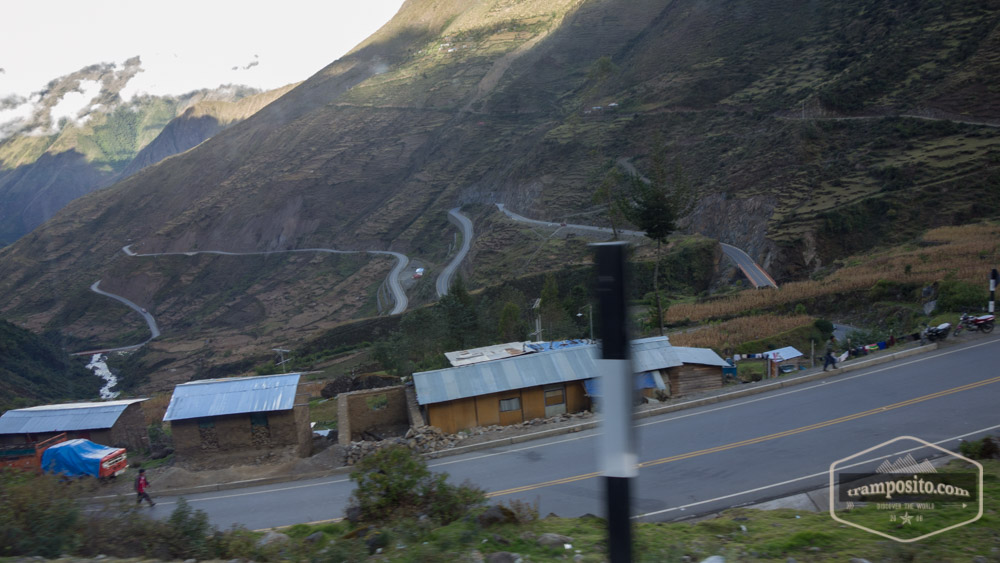 |
|
The Interociana It is not easy to build roads in a land of such massive geological contrast. Here the interocianca is placed in the slopes of the andes to descent to the amazon basin. |
|
042 - The sacred valley |
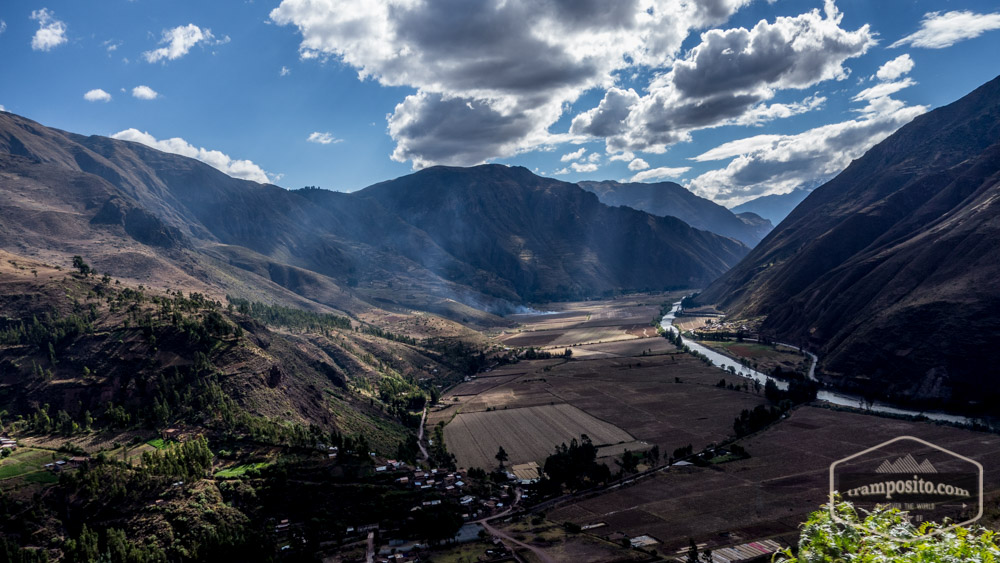 |
|
One may write books... Located just outside of Cuscoo, the sacred valley is full of historic importance. Many archilogical sites have their location here. Still today it is a lively place. |
|
043 - The fox |
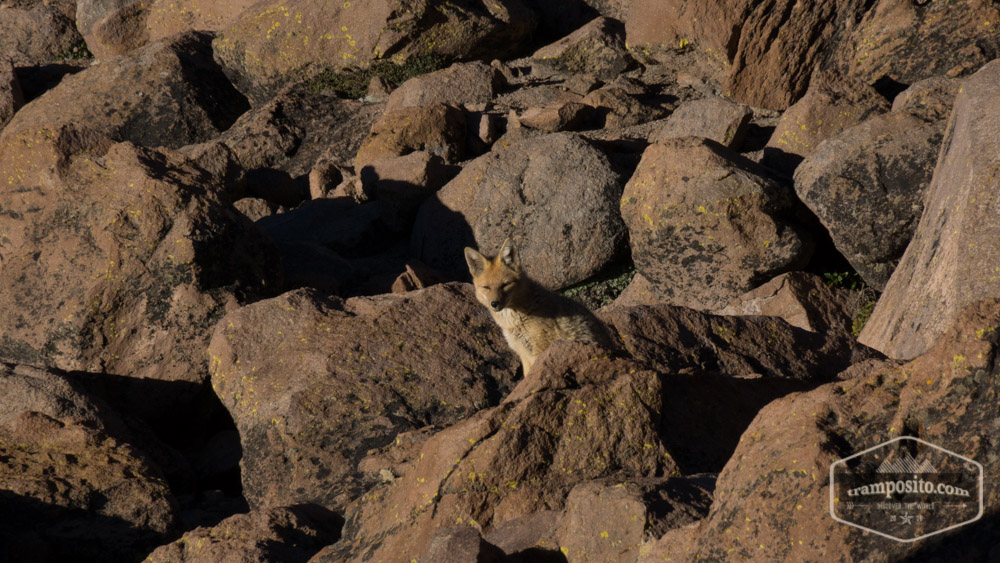 |
|
A vistor, looking for a snack... Foxes are not too shy with humans. They learn to take opportunities from civilization. Here the fox looks for left overs at the base camp at Nevado Chachani. So take care of your food when camping there. |
|
044 - Rain in the rain forest |
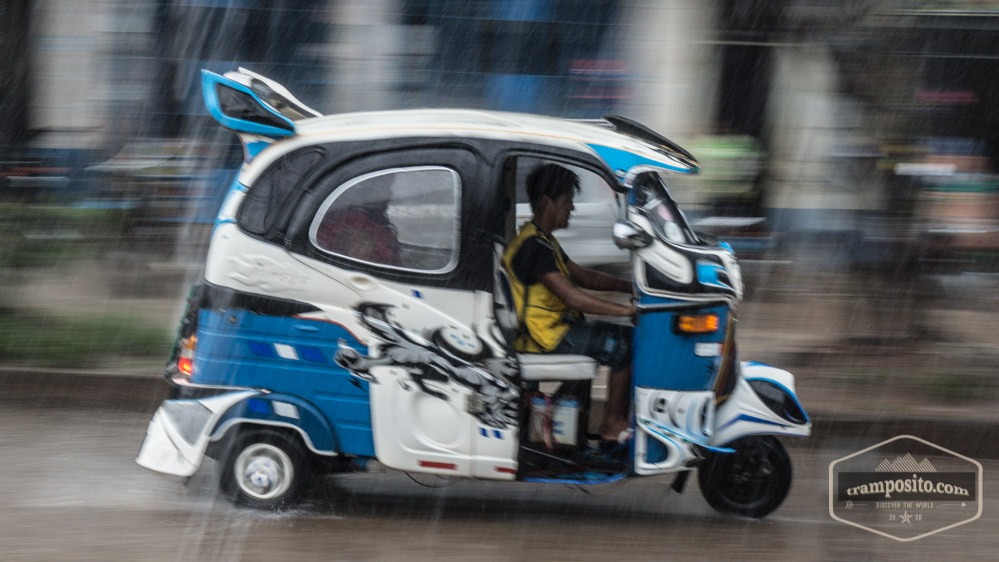 |
|
Rain forest has it's name not without reason The driver with his three wheeler got hit hard by massive rainfalls in Puerto Maldonada. If it rains it rains heavily. The lucky ones make it under a dry shelter in time. |
